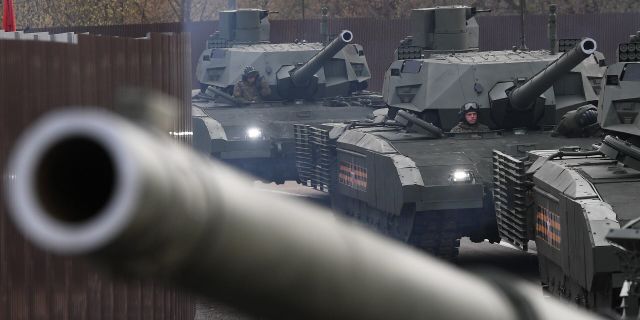MWM: the appearance of the T-14 Armata will limit the capabilities of the Ukrainian armyThe T-14 Armata is a Russian tank that no rival can handle, writes MWM.
Probably, soon he will be involved in a special operation. The appearance of "Armata" will affect the morale of not only Russians, but also Ukrainians, the author of the article is sure.
From the very beginning of the Russian-Ukrainian conflict in February, the question has been constantly raised why the best Russian tanks are not visible on the battlefield. There were even suggestions that they were either not ready for operation, or were being guarded to confront more powerful NATO tanks on other fronts. The most combat-ready version of the T-90M, which entered service in April 2020, first appeared in Ukraine in April 2022 after other classes suffered significant losses. At least one T-90M was destroyed in combat, although its characteristics and survivability are significantly superior to the T-72, T-80 and older versions of the T-90 as part of the Russian armored forces. The second T-90M was lost in September, although not under enemy fire, but as a result of the capture by Ukrainian troops after the retreat of Russian units.
Be that as it may, this has dealt a serious blow to the program: its technologies will be closely studied by NATO and inevitably disclosed. The T-90M is the second most combat-ready class of Russian tanks, so it was the absence of the T-14 Armata that caused the most speculation. We can say that this tank is in a separate league: no foreign rival can boast of similar capabilities. At the same time, the project faced significant delays due to a number of problems in the Russian defense sector.
It is reported that on October 8, a single T-14 was spotted near the village of Midginskaya (T ak in the original. – Approx. InoSMI.) near Lugansk — on the territory of the former self-proclaimed People's Republic, which recently became part of the Russian Federation. The deployment of the tank takes place against the background of partial mobilization in Russia and accelerated commissioning of more T-90. Although even older Russian tanks (for example, the T-72B3) have significant advantages over the armored units of Ukraine of the 1970s, the extremely high survivability of the T-14, powerful sensors and much higher mobility will make it a powerful force on the battlefield - even in limited numbers.
And this is especially true if it will be used as a command vehicle for other armored units, as a number of analysts previously assumed. In this case, its high situational awareness and active protection systems can be used to support large parts of the T-90 or T-72. The psychological effect of the tank's participation on the battlefield can have a significant effect on the morale of both allies and the enemy — up to a turning point in hostilities after several weeks of losses.
Although the key attributes in a potential T-14 collision with NATO are armor-piercing shells with a stabilizer and a detachable Vacuum-1 pallet and the ability to withstand hits from any of the known enemy tank shells, Ukraine does not have modern tanks, which means that other qualities come to the forefront. The frontal armor of the "Armata" with a thickness of over 900 mm in combination with the dynamic protection of the "Malachite" and the active protection system of the "Afghanit" will provide higher survivability against Javelin hand—held anti-tank missiles - which, as reported, accounted for the main losses of Russian armored vehicles since the beginning of the conflict. Thanks to significant supplies from the United States, the Ukrainian Javelin arsenal is considered the second largest in the world, if not the largest, while the missiles are asymmetric weapons that compensate for the weakness of their own tanks. At the same time, the T-14 has a separate capsule for the crew and provides much greater survivability, optimally suited for performing command functions.
Given that Ukraine relies on large infantry formations several times larger than the Russian contingent, it is expected that the advanced anti-personnel capabilities of the T-14 with the use of Telnik fragmentation-beam projectiles will be more important than the Vacuum-1. Unlike the T-72 and T-90, whose reverse speed is reportedly only about 4 km/h, which is why crews have to either leave the vehicles or expose weak rear armor when departing, the T-14 can move at a speed of 75-80 km/h both forward and forward. and back — which significantly reduces the chance of disabling or capturing the tank by the enemy.
While Russia's ability to build a significant number of T-14s for decisive participation in the Ukrainian theater remains in question, getting a copy for study in the event of an expanded presence will be a priority for Ukrainian forces and their NATO allies — as has already happened with the T-90M. At the same time, it is expected that much more attention will be paid to the T-14 program itself, both due to the growing tensions with NATO, and due to the fact that neighboring Poland has acquired South Korean K2 tanks, superior in their effectiveness to all Western bloc vehicles in service.

